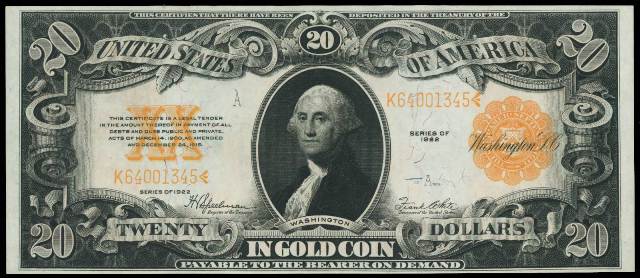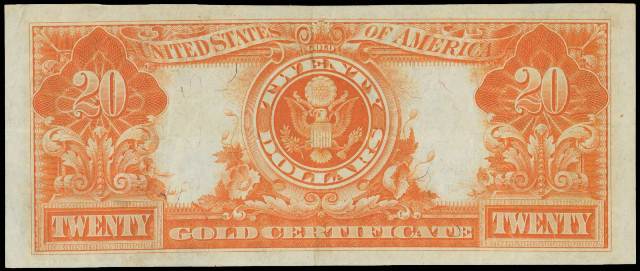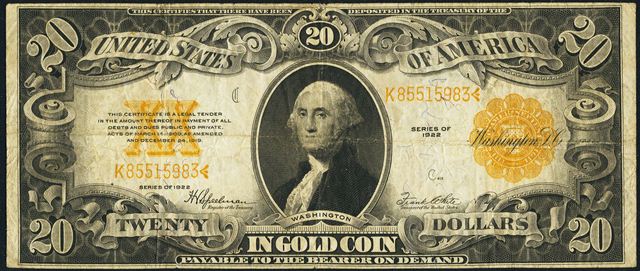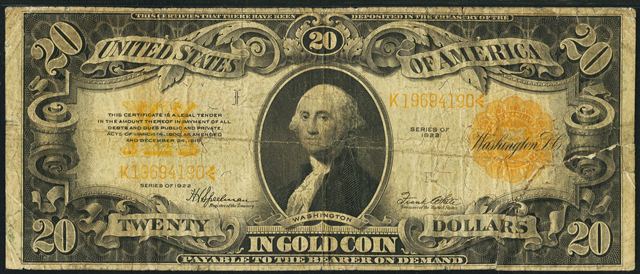Series of 1922 $20 Gold Certificate Value
History: 1906 and 1922 $20 gold certificates look exactly the same. The 1906 is slightly rarer and we would be happy to help with inquiries about it. However, we are specifically looking at the 1922 specimen for this guide. 1922 is the last year that large size gold certificates were issued. This also happens to be the last time that George Washington was featured on a twenty dollar bill. Of course today his image can be found on all United States one dollar bills. Despite saying series of 1922, some of these were printed years later. All examples are signed by Speelman and White. There are no varieties other than the star issues. If the serial number on your 1922 $20 gold note begins with a star symbol then the value increases three times on average.
Nickname: There really isn’t a popular or catchy nickname for 1922 $20 gold certificates. We sometimes hear the term “gold coin note” get kicked around. “In Gold Coin” is written below the portrait of George Washington very prominently. However, that is not really a nickname. So for now we will just have to stick to 1922 $20 gold certificate.
Other Facts: One of the biggest misconceptions surrounding the 1922 $20 gold certificate is that it is redeemable for a $20 gold coin like a Saint Gaudens gold piece. While it is true that before 1933 both the coin and the bill were worth $20 of gold, that is not true today. Now the $20 gold coin is worth roughly whatever an ounce of gold is worth. The piece of paper money is still worth its face value of twenty dollars and then you can add a premium based on its numismatic value. However, it is certainly not redeemable for gold any longer.
Values and Grading: We have already covered that there are no signature combination varieties to the 1922 $20 gold certificate. Star notes are rarer than standard issues. And as per usual, any serial number under 100 is worth extra money. However, 99% of the time the only value factor will come down to condition. 1922 $20 bills are definitely common. They can be bought at will with ease. There just happens to be a huge price gap between circulated and perfect condition, maybe one of the largest ranges of any common collectible note. Please read our guide below to learn more about how grades and condition affects the value of these notes.
Choice Uncirculated or Better: We all know that any choice uncirculated note should have no folds, bends, or any imperfections or distractions. However, when we are specifically talking about 1922 $20 gold certificates there are a few things to look for. First off, the black colors should be very dark and oily. The orange and yellow colors should be especially vibrant. 1922 $20 bills always have better than average embossing and there should be lots of paper wave present. The paper on these notes is nice and thick. Just in general you shouldn’t be able to see any signs of age at all. Anything that looks like a fold probably is. Notes in perfect uncirculated condition should sell for $1,500 or more. The value of these notes has increased substantially in the past couple of years as collectors have learned that this grade is quite scarce. Often times the top and bottom margins are narrow, which keeps grades above 65 very elusive (and valuable).

A 1922 $20 Gold Certificate This Nice Could Be Worth Around $2,000
Extremely Fine to About Uncirculated: 1922 $20 gold certificates in the 40 to 58 grade should have loads of eye appeal. One to three folds are acceptable, as are other minor imperfections. Prices usually range from $500 to $1,000. We see lots of 1922 twenty dollar bills in this grade. It is refreshing to see crisp and original notes that have not been messed with. Notes like this are sadly often the target of greedy people who try to improve their appearance to make them appear higher in grade than they really are.

A Few Light Folds Can Be Seen On The Back Of This 1922 $20 Gold Certificate
Fine to Very Fine: Many casual collectors have no problem paying a couple hundred dollars for a nice looking fine or very fine 1922 $20 gold certificate. Notes in this grade will have obvious signs of circulation. Somewhat toned paper, several folds, and a softer appearance around the printed details are all expected here. Values range from around $100 to about $300. A couple pinholes and some light soiling from circulation are acceptable for the grade. However, once you start getting into damage and significant problems then you need to discount the value further.

This 1922 $20 Bill Still Has Great Color But The Details And Paper Are Getting Softer
Very Good and Lower: There are probably thousands of 1922 $20 gold certificates available in poor condition. This may seem like an exotic issue, but you have to remember that tens of millions were printed. There is a high survival rate. Something in the poor, fair, about good, good, and very good range is going to have spent years in circulation. It was probably kept as a curiosity item by someone who could afford to keep $20 in the 1930s or 1940s. Expect to find tears, margin damage, rust, tape, etc. These will have also lost a lot of that vibrant color that makes them so popular. You can usually buy something in this grade for around $75 (more or less) based on the extent of damage.

This Note Is Fairly Nice Looking For The Grade. It Is Worth Around $100.
Need an Appraisal or Offer? Please give us a chance to make an offer on your 1922 $20 gold certificate. We are aggressive buyers and you might be surprised at how much we can pay. Just send us scans or digital photos of the front and back of your note and we can go from there. Sales@AntiqueMoney.com


